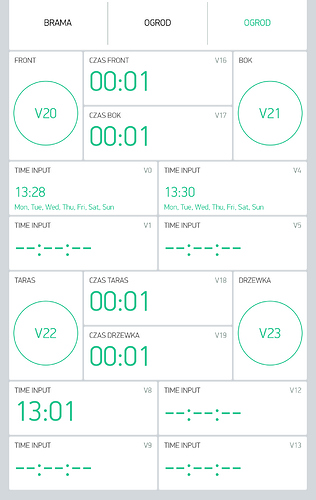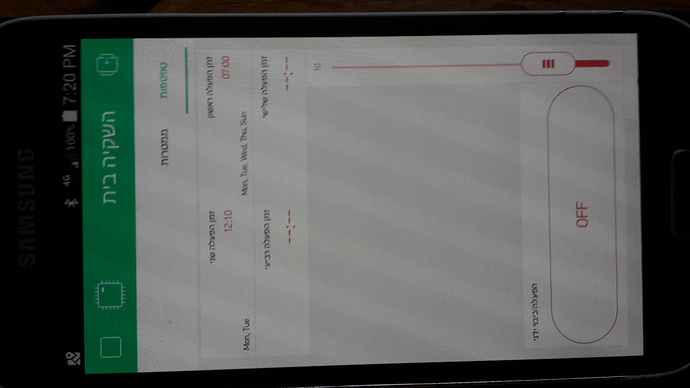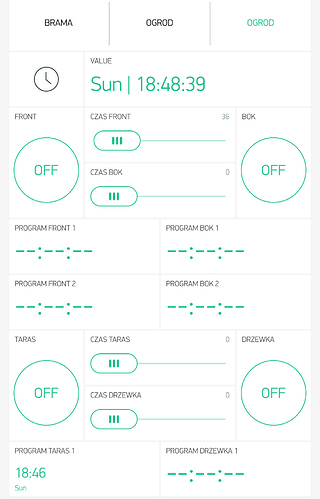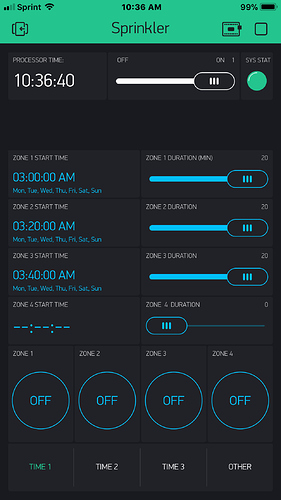Hi All.
I am new to blynk and needed a simple scheduler for my home irrigation system using 4 relay device (sonoff 4ch pro).
The device receives for each relay, duration time (V16…V19), and 4 optional start times (and active days) using the time input widget(V0…V3 for relay 0 V4…V7 for relay 1 … ) .
Also at the app for each relay I have a button (V20…V23) that enables activating the relay immediately (the relay will turn off after the configured duration time).
since I could not find BLYNK code that match my requirements I wrote one and am sharing it here if anyone finds it useful.
/*************************************************************
Download latest Blynk library here:
https://github.com/blynkkk/blynk-library/releases/latest
Blynk is a platform with iOS and Android apps to control
Arduino, Raspberry Pi and the likes over the Internet.
You can easily build graphic interfaces for all your
projects by simply dragging and dropping widgets.
Downloads, docs, tutorials: http://www.blynk.cc
Sketch generator: http://examples.blynk.cc
Blynk community: http://community.blynk.cc
Follow us: http://www.fb.com/blynkapp
http://twitter.com/blynk_app
Blynk library is licensed under MIT license
This example code is in public domain.
*************************************************************
This example runs directly on ESP8266 chip.
Note: This requires ESP8266 support package:
https://github.com/esp8266/Arduino
Please be sure to select the right ESP8266 module
in the Tools -> Board menu!
Change WiFi ssid, pass, and Blynk auth token to run :)
Feel free to apply it to any other example. It's simple!
*************************************************************/
/* Comment this out to disable prints and save space */
#define BLYNK_PRINT Serial
#define WIFI_LED 13
#include <ESP8266WiFi.h>
#include <BlynkSimpleEsp8266.h>
#include <TimeLib.h>
#include <WidgetRTC.h>
// You should get Auth Token in the Blynk App.
// Go to the Project Settings (nut icon).
char auth[] = "xxxxxxxxxxxxxxxxxxxxxxxxxxxxxxxx";
// Your WiFi credentials.
// Set password to "" for open networks.
char ssid[] = "xxxxxx";
char pass[] = "xxxxxxxxxxxx";
byte switch_pins[] = {12 , 5 , 4 , 15}; // number of gpio to be used as switch/relay control
/////////////////////////////////////////////////////////////////////
// this code can control up to 4 switches //
// for each switch up to 4 schedule start times can be configured //
// for each switch one duration is used (when schedule time is //
// reached the switch turns on for the duration) //
/////////////////////////////////////////////////////////////////////
int start_time_sec[4][4]; // array of 4 start times (in seconds) for 4 switches [switch number][schedule timer number]
bool start_valid[4][4]; // is the start time valid ?
bool weekdays[4][4][8]; // array of 8 days (day 0 not used) for each schedule time
byte active_duration[4]; // duration per switch (in minuets)
bool wifi_led_status = false;
// when activating a switch a timer is set for the configured duration
// when the duration ends the switch is turned off by the timer
// the number of the timer is saved using end_timer_id
// if switch is manualy turned off the end_timer_id is used to stop the timer.
int end_timer_id[4] = {32, 32, 32, 32};
// timer object declaration
BlynkTimer timer;
// this code use Real Time Clock widget in the blynk app to keep the clock updated from net
WidgetRTC rtc;
BLYNK_CONNECTED() {
// Synchronize time on connection
rtc.begin();
Blynk.syncAll();
}
//////////////////////////////////////////////////////////
// get schedual parameters from App //
//////////////////////////////////////////////////////////
void set_time(BlynkParam param, byte switch_no, byte time_no){
TimeInputParam t(param);
// Process start time
if (t.hasStartTime())
{
Serial.println(String("Start: ") +
t.getStartHour() + ":" +
t.getStartMinute() + ":" +
t.getStartSecond());
Serial.println(String("Start in sec: ") + param[0].asLong() + String(" for switch") + switch_no + String(" time_no: ") + time_no);
start_time_sec[switch_no][time_no]= param[0].asLong();
start_valid[switch_no][time_no] = true;
}
else
{
// Do nothing
Serial.println(String("No Start Time Given for switch: ") + switch_no + String(" time_no: ") + time_no);
start_valid[switch_no][time_no] = false;
}
// Process weekdays (1. Mon, 2. Tue, 3. Wed, ...)
for (int i = 1; i <= 7; i++) {
if (t.isWeekdaySelected(i)) {
Serial.println(String("Day ") + i + " is selected");
weekdays[switch_no][time_no][i] = true;
}
else {
weekdays[switch_no][time_no][i] = false;
}
}
Serial.println();
}
BLYNK_WRITE(V0) { set_time(param, 0,0); }
BLYNK_WRITE(V1) { set_time(param, 0,1); }
BLYNK_WRITE(V2) { set_time(param, 0,2); }
BLYNK_WRITE(V3) { set_time(param, 0,3); }
BLYNK_WRITE(V4) { set_time(param, 1,0); }
BLYNK_WRITE(V5) { set_time(param, 1,1); }
BLYNK_WRITE(V6) { set_time(param, 1,2); }
BLYNK_WRITE(V7) { set_time(param, 1,3); }
BLYNK_WRITE(V8) { set_time(param, 2,0); }
BLYNK_WRITE(V9) { set_time(param, 2,1); }
BLYNK_WRITE(V10) { set_time(param, 2,2); }
BLYNK_WRITE(V11) { set_time(param, 2,3); }
BLYNK_WRITE(V12) { set_time(param, 3,0); }
BLYNK_WRITE(V13) { set_time(param, 3,1); }
BLYNK_WRITE(V14) { set_time(param, 3,2); }
BLYNK_WRITE(V15) { set_time(param, 3,3); }
BLYNK_WRITE(V16) { active_duration[0] = param.asInt(); }
BLYNK_WRITE(V17) { active_duration[1] = param.asInt(); }
BLYNK_WRITE(V18) { active_duration[2] = param.asInt(); }
BLYNK_WRITE(V19) { active_duration[3] = param.asInt(); }
/////////////////////////////////////////////////////////////////
// Handle switch events (from app or from scheduler ) //
/////////////////////////////////////////////////////////////////
// turn off switch after active duration ends
void turn_off_switch_no_0(){ turn_on_off(0,0); Blynk.virtualWrite(V20,0); Serial.println(String("timer turn off switch 0 ") );}
void turn_off_switch_no_1(){ turn_on_off(0,1); Blynk.virtualWrite(V21,0); Serial.println(String("timer turn off switch 1 ") );}
void turn_off_switch_no_2(){ turn_on_off(0,2); Blynk.virtualWrite(V22,0); Serial.println(String("timer turn off switch 2 ") );}
void turn_off_switch_no_3(){ turn_on_off(0,3); Blynk.virtualWrite(V23,0); Serial.println(String("timer turn off switch 3 ") );}
// handle switch state
void turn_on_off(int on_off, byte switch_no){
if (on_off==1)
{
digitalWrite(switch_pins[switch_no],HIGH);
long active_duration_ms = ((long)active_duration[switch_no])*60000;
switch (switch_no) {
case 0:
Blynk.virtualWrite(V20,1);
end_timer_id[0]=timer.setTimeout(active_duration_ms, turn_off_switch_no_0);
break;
case 1:
Blynk.virtualWrite(V21,1);
end_timer_id[1]=timer.setTimeout(active_duration_ms, turn_off_switch_no_1);
break;
case 2:
Blynk.virtualWrite(V22,1);
end_timer_id[2]=timer.setTimeout(active_duration_ms, turn_off_switch_no_2);
break;
case 3:
Blynk.virtualWrite(V23,1);
end_timer_id[3]=timer.setTimeout(active_duration_ms, turn_off_switch_no_3);
break;
}
Serial.println(String("turn ON switch: ") + switch_no);
}
else
{
digitalWrite(switch_pins[switch_no],LOW);
timer.deleteTimer(end_timer_id[switch_no]);
end_timer_id[switch_no]=32;
Serial.println(String("turn OFF switch: ") + switch_no);
}
}
// set switch state from APP
BLYNK_WRITE(V20) { turn_on_off(param.asInt(),0); }
BLYNK_WRITE(V21) { turn_on_off(param.asInt(),1); }
BLYNK_WRITE(V22) { turn_on_off(param.asInt(),2); }
BLYNK_WRITE(V23) { turn_on_off(param.asInt(),3); }
// schedual events handling
void activetoday(){ // check if schedule #1 should run today
if(Blynk.connected())
{
digitalWrite(WIFI_LED,LOW);
}
else
{
wifi_led_status =!wifi_led_status;
digitalWrite(WIFI_LED,wifi_led_status);
}
if(year() != 1970){
unsigned int nowseconds = ((hour() * 3600) + (minute() * 60) + second());
int dayadjustment = -1;
if(weekday() == 1){
dayadjustment = 6; // needed for Sunday Time library is day 1 and Blynk is day 7
}
for (int switch_cnt = 0; switch_cnt<= 3; switch_cnt++) {
for (int timer_cnt = 0; timer_cnt<= 3; timer_cnt++) {
if (start_valid[switch_cnt][timer_cnt] == true) {
if (weekdays[switch_cnt][timer_cnt][weekday() + dayadjustment]==true){
if (nowseconds >= start_time_sec[switch_cnt][timer_cnt]){
if(nowseconds < start_time_sec[switch_cnt][timer_cnt]+90){
turn_on_off(1,switch_cnt);
Serial.println(String("turn ON switch: ") + switch_cnt);
}
}
}
}
}
}
}
}
/////////////////////////////////////
// BLYNK
void setup()
{
// Debug console
Serial.begin(9600);
for (int i = 0; i<4 ; i++){
pinMode(switch_pins[i], OUTPUT);
}
pinMode(WIFI_LED, OUTPUT);
Blynk.begin(auth, ssid, pass);
timer.setInterval(60000L, activetoday); // check every 60s if ON / OFF trigger time has been reached
setSyncInterval(10 * 60); // Sync interval in seconds (10 minutes)
}
void loop()
{
Blynk.run();
timer.run();
}




